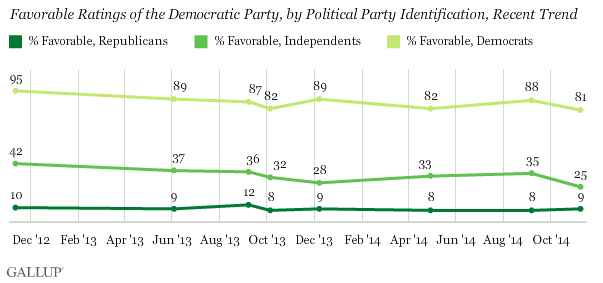Story Highlights
- Democrats' favorable rating at a record-low 36%
- Democratic Party lost support among Democrats, independents
- Republican Party's favorable rating remains steady at 42%
WASHINGTON, D.C. -- After the midterm elections that saw the Democratic Party suffer significant losses in Congress, a record-low 36% of Americans say they have a favorable opinion of the party, down six percentage points from before the elections. The Republican Party's favorable rating, at 42%, is essentially unchanged from 40%. This marks the first time since September 2011 that the Republican Party has had a higher favorability rating than the Democratic Party.

These results come from a Nov. 6-9 Gallup poll, conducted after Republicans enjoyed a breathtaking sweep of important contests throughout the country in this year's midterms. The party gained control of the Senate and will likely capture its largest House majority in nearly a century. Additionally, the GOP now controls 31 governorships and two-thirds of state legislative chambers.
The descent in Democrats' ratings caps a wild political ride for both parties over the past two years. After President Barack Obama's re-election in 2012, the Democratic Party's favorable rating spiked to 51%, the first time either party had enjoyed majority support since 2009. However, after the post-election glow wore off, the party's image settled back down near the 45% average for the Obama presidency. Meanwhile, Americans' favorable ratings of the Republican Party collapsed to 28% during the fall 2013 federal government shutdown, the lowest such rating for either party since Gallup first asked the question in 1992.

Because of congressional Republicans' apparent political miscalculation in allowing the shutdown, some raised the possibility of a Democratic takeover of the House of Representatives in the 2014 midterms. But the speculation was short lived. While Republicans agreed to a compromise that ended the shutdown, the Obama administration made a number of political blunders, including the botched rollout of the federal government's healthcare website; a series of international crises in Ukraine, Iraq and Syria; the Veterans Affairs hospitals scandal; and a criticized response to the first appearance of the Ebola virus on U.S. soil. Whatever momentum the Democrats gained during the government shutdown was lost. The Democratic Party's image stagnated as Republicans' slowly improved, putting the parties at rough parity heading into the midterms.
The GOP currently has an image advantage over the Democratic Party; still, neither party is held in particularly high regard. This is yet another sign of Americans' dissatisfaction with their political system.
Democrats Now Less Likely to Have Positive Image of Own Party
Across party groups, the Republican Party's image held steady from Gallup's last update in September. But support for the Democratic Party dropped among independents and among Democrats themselves. Currently, 81% of self-identified Democrats have a favorable view of their party, down from 88% in September and 95% shortly after the 2012 election. Independents' ratings of the Democratic Party, at 25%, are down 10 points from September.

Bottom Line
After the 2012 election, many political analysts focused on the GOP's "image problem." Now, it is the Democrats who appear to have the more battered image. Their favorability rating has never been lower, and they are reeling from defeats that cost them control of the U.S. Senate and strengthened the Republican House majority to levels likely not seen in 90 years.
On the other hand, the American public does not admire Republicans more, their numerous election victories notwithstanding. Neither party can say it is making significant progress in improving its image among the U.S. population, but undoubtedly the 2014 elections augmented the GOP's ability to shape the agenda in Washington and in state capitals across the country. This newfound power could pose its own problems for the GOP. The party could be on the verge of winning over a greater segment of the country or, not unlike the Democrats this year, could see its brand go into a free fall. This will depend on what Republican leaders do in the coming two years.
Survey Methods
Results for this Gallup poll are based on telephone interviews conducted Nov. 6-9, 2014, with a random sample of 828 adults, aged 18 and older, living in all 50 U.S. states and the District of Columbia. For results based on the total sample of national adults, the margin of sampling error is ±4 percentage points at the 95% confidence level.
Each sample of national adults includes a minimum quota of 50% cellphone respondents and 50% landline respondents, with additional minimum quotas by time zone within region. Landline and cellular telephone numbers are selected using random-digit-dial methods.
View survey methodology, complete question responses, and trends.
Learn more about how Gallup Poll Social Series works.

